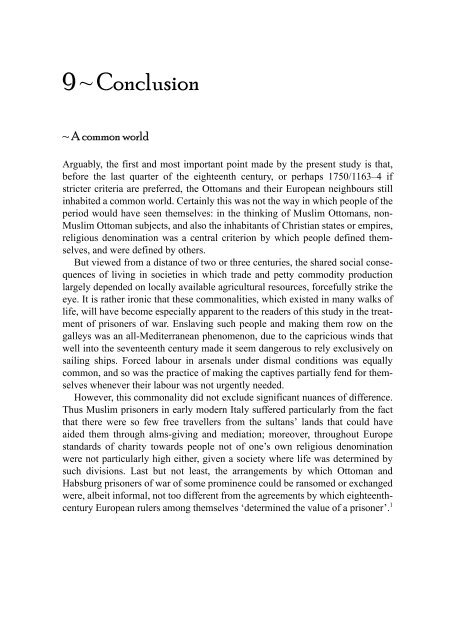The Ottoman Empire and the World Around It - Course Information
The Ottoman Empire and the World Around It - Course Information
The Ottoman Empire and the World Around It - Course Information
Create successful ePaper yourself
Turn your PDF publications into a flip-book with our unique Google optimized e-Paper software.
9 ~ Conclusion<br />
~ A common world<br />
Arguably, <strong>the</strong> first <strong>and</strong> most important point made by <strong>the</strong> present study is that,<br />
before <strong>the</strong> last quarter of <strong>the</strong> eighteenth century, or perhaps 1750/1163–4 if<br />
stricter criteria are preferred, <strong>the</strong> <strong>Ottoman</strong>s <strong>and</strong> <strong>the</strong>ir European neighbours still<br />
inhabited a common world. Certainly this was not <strong>the</strong> way in which people of <strong>the</strong><br />
period would have seen <strong>the</strong>mselves: in <strong>the</strong> thinking of Muslim <strong>Ottoman</strong>s, non-<br />
Muslim <strong>Ottoman</strong> subjects, <strong>and</strong> also <strong>the</strong> inhabitants of Christian states or empires,<br />
religious denomination was a central criterion by which people defined <strong>the</strong>mselves,<br />
<strong>and</strong> were defined by o<strong>the</strong>rs.<br />
But viewed from a distance of two or three centuries, <strong>the</strong> shared social consequences<br />
of living in societies in which trade <strong>and</strong> petty commodity production<br />
largely depended on locally available agricultural resources, forcefully strike <strong>the</strong><br />
eye. <strong>It</strong> is ra<strong>the</strong>r ironic that <strong>the</strong>se commonalities, which existed in many walks of<br />
life, will have become especially apparent to <strong>the</strong> readers of this study in <strong>the</strong> treatment<br />
of prisoners of war. Enslaving such people <strong>and</strong> making <strong>the</strong>m row on <strong>the</strong><br />
galleys was an all-Mediterranean phenomenon, due to <strong>the</strong> capricious winds that<br />
well into <strong>the</strong> seventeenth century made it seem dangerous to rely exclusively on<br />
sailing ships. Forced labour in arsenals under dismal conditions was equally<br />
common, <strong>and</strong> so was <strong>the</strong> practice of making <strong>the</strong> captives partially fend for <strong>the</strong>mselves<br />
whenever <strong>the</strong>ir labour was not urgently needed.<br />
However, this commonality did not exclude significant nuances of difference.<br />
Thus Muslim prisoners in early modern <strong>It</strong>aly suffered particularly from <strong>the</strong> fact<br />
that <strong>the</strong>re were so few free travellers from <strong>the</strong> sultans’ l<strong>and</strong>s that could have<br />
aided <strong>the</strong>m through alms-giving <strong>and</strong> mediation; moreover, throughout Europe<br />
st<strong>and</strong>ards of charity towards people not of one’s own religious denomination<br />
were not particularly high ei<strong>the</strong>r, given a society where life was determined by<br />
such divisions. Last but not least, <strong>the</strong> arrangements by which <strong>Ottoman</strong> <strong>and</strong><br />
Habsburg prisoners of war of some prominence could be ransomed or exchanged<br />
were, albeit informal, not too different from <strong>the</strong> agreements by which eighteenthcentury<br />
European rulers among <strong>the</strong>mselves ‘determined <strong>the</strong> value of a prisoner’. 1


